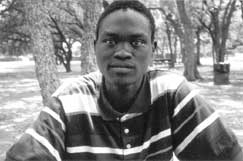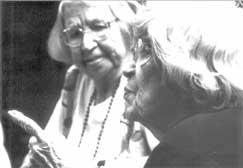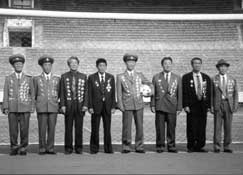
The IFP Los Angeles Film Festival (once known as the Los Angeles Independent Film Festival until it was taken over by the Independent Feature Project) took place a little too close to an out-of-town trip for comprehensive or timely coverage in this quarter. But the event did feature three documentaries so good that they deserve mentioning, even if belatedly.
Perhaps the best is Lost Boys of Sudan, from producer-directors Jon Shenk and Megan Mylan. Underneath an apparently artless surface, their film is a clear-eyed though sympathetic account of both a Sudanese boy’s struggle to claim a promised education in the U.S. and the culture of self-congratulatory false pledges that awaits him.
Naturally, there is no such thing as an objective cinema, but the filmmakers have to do very little to convince us of the charm and energy of the boys they find in a refugee camp in Kenya. As children, all of them had survived arduous treks away from the fighting in their native Sudan, where black-skinned tribes people from the south were being slaughtered by the ruling Arab regime’s army from the north. Generally religious and studious, and seemingly devoted to one another, the boys pinned their hopes on what at first look to be scholarships to the United States, which promise room and board while they attend high school and, maybe later, either trade school, community college, or even college.
Lost Boys of Sudan follows two boys who make their way to New Orleans, where they find themselves tossed into low-income public housing with some other Sudanese. Promised help from their church "sponsors" turns out to be a surfeit of shabby used couches and little else. For education, work or charity they’re on their own, a tough assignment for refugees from simple agricultural backgrounds in the industrialized (and crime-ridden) West.
The pair end up with vastly different fates, partly due to determination, but also to sheer chance. Largely, the film concerns itself with getting to know these two, understanding what they’re going through, how they adapt (or don’t), and so forth. The white "Christians" and educators who surround them are part of the environment, and though Shenk and Mylan refrain from passing any overt judgments, they don’t leave a pretty picture behind. Parsimonious with everything, especially compassion and empathy, they bring home what moral giants the Sudanese kids really are.
A heady brew of acute social observations, Lost Boys of Sudan is ultimately most notable for its portrait of two heady, heroic boys, one exceptionally ambitious and lucky, the other not quite enough.
 Far simpler, but exceptionally intimate and moving, is Laura Gabbert’s Sunset Story. Gabbert set up her camera at Sunset Hall, a retirement home in downtown Los Angeles that was specifically designed for elderly political radicals. But once the filmmaker quickly establishes locale and background, she zeroes in on her real subject: The unlikely friendship between two women. Irja is a cheerful 81-year-old woman who grew up in a small country town and spent most of her professional life as a special needs teacher. Lucile, 92, is more than a little bit waspy, and a graduate of the University of Chicago’s famed school of social work.
Far simpler, but exceptionally intimate and moving, is Laura Gabbert’s Sunset Story. Gabbert set up her camera at Sunset Hall, a retirement home in downtown Los Angeles that was specifically designed for elderly political radicals. But once the filmmaker quickly establishes locale and background, she zeroes in on her real subject: The unlikely friendship between two women. Irja is a cheerful 81-year-old woman who grew up in a small country town and spent most of her professional life as a special needs teacher. Lucile, 92, is more than a little bit waspy, and a graduate of the University of Chicago’s famed school of social work.
The two clash a great deal, but within the confines of an extraordinarily close friendship. A poignancy suffuses Sunset Story because, even before it is said out loud, it is clear that Lucile already has one foot in the other world. But Gabbert never lets a single mood overcome her film and she uses her camera as all documentarians should but are seldom able to do, as a fantastic X-ray machine on life.
 The Game of Their Lives may be the most purely entertaining of the three. Daniel Gordon spent four years waiting for permission to shoot inside North Korea, but based on the film that has resulted, it was worth it. In 1966, an unknown football/soccer team from North Korea – then as now an international pariah though, if anything, even less penetrated by the outside world – entered the World Cup. Based in a mid-sized English industrial town for its first round of games, it began a series of upsets that grew to include some of the world’s great sporting powers in the final round.
The Game of Their Lives may be the most purely entertaining of the three. Daniel Gordon spent four years waiting for permission to shoot inside North Korea, but based on the film that has resulted, it was worth it. In 1966, an unknown football/soccer team from North Korea – then as now an international pariah though, if anything, even less penetrated by the outside world – entered the World Cup. Based in a mid-sized English industrial town for its first round of games, it began a series of upsets that grew to include some of the world’s great sporting powers in the final round.
I won’t give the name of the opposing victims away, but even knowing (as I did, unfortunately), who they were ahead of time doesn’t take much of the edge off the movie’s excitement. The North Koreans played such a unique team-oriented style for the time (or so the movie says) and the individual players were so much smaller than most of their opponents, that it’s never always clear that they can win even when you know they will win. And given the elimination rules of World Cup play, they don’t always have to win to advance; sometimes they can lose or tie and survive.
After their first game against a particularly nasty Russian squad, the North Koreans picked up a large, loyal and noisy contingent of supporters from among the English locals. In and of itself, the successful underdogs and their cheerful English fans, both depicted in copious amounts of archival footage, would make The Game of Their Lives a good show.
But it’s Gordon’s contemporary North Korean footage that elevates the film. The team and manager returned home as national heroes and were given various sinecures, pensions, or military positions commensurate with what the government held was a great accomplishment. Gordon visits them and each in turn describes the games, his particular role as a player, his relationship with the English, and his gratitude and dedication to North Korea’s leaders, Kim Il Sung and his successor and son, Kim Jong Il.
Gordon also visits the men at home or work (coaching a factory football/soccer team, for example) and in a huge empty square dominated by a portrait of Kim Jong Il. He watches a little girl play violin at prodigy level. And he goes to a mass sports exhibition, where a whole vast playing field is covered with athletes performing different synchronized feats, while in the stands spectator-participants use placards to depict nationalist and ideological symbols and images.
So warm, happy nostalgia is mixed in with a visually noncommittal travelogue through a bizarre (to be polite) mindscape. If it’s difficult to draw a precise conclusion from all this, that’s partly to Gordon’s credit; he doesn’t manipulate you towards one or another. He’s made a film that’s both fun to watch and drives you to at least try and understand a modern political enigma.
As is the case with any film festival, the IFP Los Angeles Film Festival produced more evidence that too many people are making movies. Young people fantasize themselves as Artists and then try and come up with the documentation to validate the fantasy. With Gabriel Orozco, a documentary about the globe-trotting, Mexican-born conceptual artist, Juan Carlos Martín makes the fatal mistake of trying to match Orozco’s artiness with his own. Salt, about of couple of sisters stuck in their bleak hometown in Iceland, is American filmmaker Bradley Rust Gray’s shot at making a Dogme-style feature. Both filmmakers reach for style as if it were a distinct entity, a reactionary approach they seem to regard as progressive. It may be modern, but then we live in a reactionary age.

